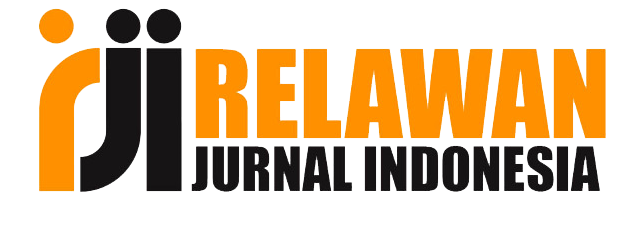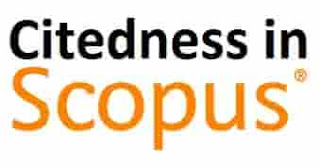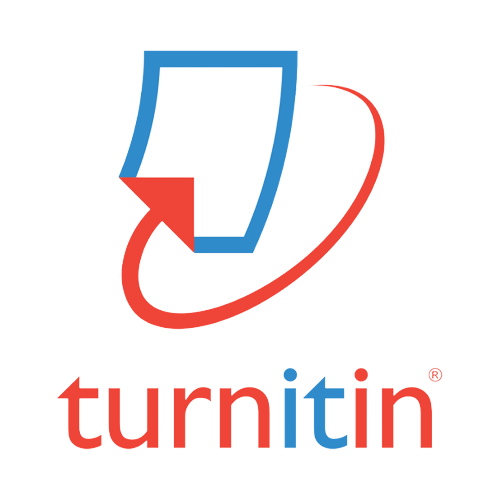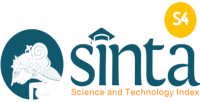Does teaching writing through Canva application assist students’ writing performance?
DOI:
https://doi.org/10.33474/j-reall.v5i1.21361Keywords:
Canva, language education, technology, writing skillsAbstract
This study involves the issues of teaching writing in English skills in junior high school in the context of the digital world, highlighting the need to utilize technology-driven tools. Canva, an effective design tool, is included in the study as a possible alternative for improving students writing skills. The study aims at looking into the impact of utilizing Canva on students' writing skills and their assessment of the application's contribution to writing creativity. The report examines six connected research that illustrates Canva’s beneficial effects on several aspects of learning and teaching. A mixed-method approach is used in the methodology, employing a randomized pre-test-post-test control group design. Thirty-eight eighth-grade SMP Negeri 2 Sukodono students participated in the study. To examine Canva's effectiveness in developing writing skills, quantitative data obtained through pretest and posttests is analyzed using the Wilcoxon test. Furthermore, data from a questionnaire are used to investigate students’ impressions of Canva’s usefulness, ease of use, and suitability for supporting writing abilities. The results show significant improvements in the experimental group, validating that Canva improves students’ writing skills positively. The results of the questionnaire show that students have a high level of acceptance and good impressions of Canvas's utility, ease of usage, and suitability for improving writing skills. The findings add to the expanding research proving Canva's effectiveness as an English language learning tool. The report encourages additional research to investigate Canva’s long-term impact in various learning contexts and deployment methodologies.
References
Al Khoeri, A.F., Nuraini, W., Ramdani, R., & Agum, S. (2021). The implementation of Canvas to enhance English teaching and learning. Proceedings International Conference on Education of Suryakancana (iCONNECTS). (Vol. 21, Issue July), 315-320 https://www.researchgate.net/publication/353514447
Astrini, F., N.M, R., & G.A. L.P, U. I. (2020). The model of strategies employed by English teachers in teaching writing skill in national plus schools. Journal of Education Research and Evaluation, 4(1), 59. https://doi.org/10.23887/jere.v4i1.23682
Aunurrahman, A., Hamied, F. A., & Emilia, E. (2017). A joint construction practice in an academic writing course in an Indonesian university context. Celt: A Journal of Culture, English Language Teaching & Literature, 17(1), 27. https://doi.org/10.24167/celt.v17i1.1137
Bonilla López, M., Van Steendam, E., Speelman, D., & Buyse, K. (2018). The differential effects of comprehensive feedback forms in the second language writing class. Language Learning, 68(3), 813–850. https://doi.org/10.1111/lang.12295
Boyle, J., Ramsay, S., & Struan, A. (2019). The academic writing skills programme: A model for technology enhanced, blended delivery of an academic writing programme. Journal of University Teaching and Learning Practice, 16(4). https://doi.org/10.53761/1.16.4.4
Candra, R. M. A., Chandra, N. E., & Hidayat, F. (2022). the use of Canva application in creative writing course : Students ’ perceptions. InCoLLT, 187–203.
Chan, J. Y. H. (2019). The choice of English pronunciation goals: Different views, experiences and concerns of students, teachers and professionals. Asian Englishes, 21(3), 264–284. https://doi.org/10.1080/13488678.2018.1482436
Elsa, E., & Anwar, K. (2021). The perception of using technology Canva application as a media for English teacher creating media virtual teaching and English learning in Loei Thailand. Journal of English Teaching, Literature, and Applied Linguistics, 5(1), 62. https://doi.org/10.30587/jetlal.v5i1.2253
Erwin, J., Pedroso, P., Sulleza, R. V. S., Hae, K., Francisco, M. C., & Jade, A. (n.d.). Students ’ views on using Canva as an all -in-one tool for creativity and collaboration. 2(2).
Fauziyah, N. L., Widodo, J. P., & Yappi, S. N. (2016). The use of ‘Canva for Education’ and the students ’ perceptions of its effectiveness in the writing procedure text. Budapest International Research and Critics Institute-Journal (BIRCI-Journal), 6368–6377.
Hadi, M. S., Izzah, L., & Paulia, Q. (2021). Teaching writing through Canva application to enhance students’ writing performance. JOLLT Journal of Languages and Language Teaching, 9(2), 228. http://ojs.ikipmataram.ac.id/index.php/jollt/index
Haerazi, Utama, I. M. P., & Hidayatullah, H. (2020). Mobile applications to improve English writing skills viewed from critical thinking ability for pre-service teachers. International Journal of Interactive Mobile Technologies, 14(7), 58–72. https://doi.org/10.3991/IJIM.V14I07.11900
Hasanah, N. (2022). The effectiveness of project-based learning on writing skill (an experimental research at junior high school). Journal of English Education and Technology, 03(02), 140–152. http://jeet.fkdp.or.id/index.php/jeet/issue/current
Hidayat, D., & Jaenudin, J. (2022). Teachers’ strategies to teach writing explanation texts. ELT Forum: Journal of English Language Teaching, 11(1), 21–30. https://doi.org/10.15294/elt.v11i1.49687
Klug, B., & Williams, U. (2016). Canva. The Charleston Advisor, 17(4), 13–16. https://doi.org/10.5260/chara.17.4.13
Mujere, N. (2016). Sampling in Research. 1994, 107–121. https://doi.org/10.4018/978-1-5225-0007-0.ch006
Mulyati, I., Astuti, I., & Ernawaty, E. (2022). Development of Canva application assisted learning media in class XII advanced study materials with 4-D Models. JTP - Jurnal Teknologi Pendidikan, 24(3), 322–329. https://doi.org/10.21009/jtp.v24i3.30483
Noor, M., & Karani, E. (2023). The effectiveness of Canva application as a media in writing greeting card at the eight grade of SMP Negeri 12 Banjarmasin. Journal on Education, 5(3), 9540–9548. https://doi.org/10.31004/joe.v5i3.1826
Parsons, T., & Knight, P. G. (2018). An exploratory study: Using adapted interactive research design and contributive research method. In How to Do Your Dissertation in Geography and Related Disciplines (pp. 55–69). https://doi.org/10.4324/9781315849218-5
Rahman, M. M., Tabash, M. I., Salamzadeh, A., Abduli, S., & Rahaman, M. S. (2022). Sampling techniques (probability) for quantitative social science researchers: A conceptual guidelines with examples. SEEU Review, 17(1), 42–51. https://doi.org/10.2478/seeur-2022-0023
Ramadhani, T. (2023). The effectiveness of canva as media in teaching writing. 8(14), 293–304.
Soegiyono. (2011). Metode Penelitian Kuantitatif, Kualitatif dan R&D.
Wilkinson, D., & Dokter, D. (2023). The Researcher’s Toolkit.
Yundayani. (2019). Investigating the effect of Canva on students’ writing skills. ENGLISH REVIEW: Journal of English Education, 7(2), 169–176. https://doi.org/10.25134/erjee.v7i2.1800
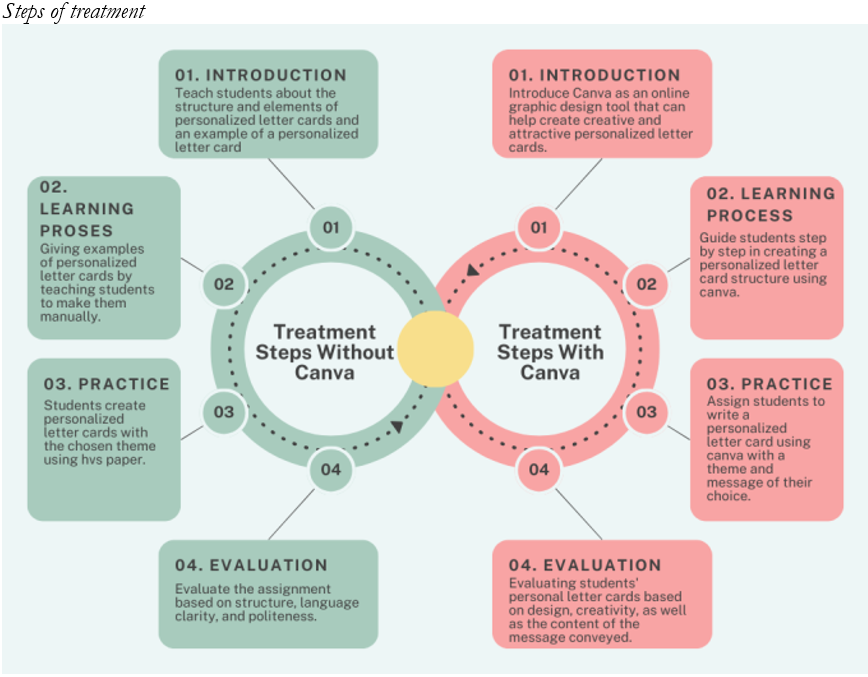
Downloads
Published
How to Cite
Issue
Section
License
Copyright (c) 2024 Maudiya Dwi Amanda, Fika Megawati, Vidya Mandarani

This work is licensed under a Creative Commons Attribution 4.0 International License.
Authors who publish this journal agree to the following terms:
- Authors retain copyright and grant the journal right of first publication with the work simultaneously licensed under a Creative Commons Attribution License that allows others to share the work with an acknowledgement of the work's authorship and initial publication in this journal.
- Authors can separately make additional contractual arrangements for non-exclusive distribution published by the journal (e.g., publish it in a book), with an acknowledgement of its initial publication in this journal.
- Authors are allowed and encouraged to send their work via online (e.g., in the institutional repositories or their website) after published by the journal.
